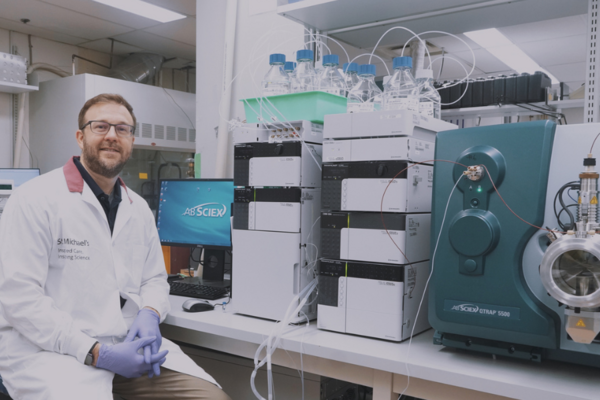Collaborating to improve patient care in the Greater Toronto Area: one laboratory test at a time

Clinical laboratories play a vital role in patient diagnosis and care. Usually based in hospitals, but also including private laboratories, they run millions of tests each year that inform patients and physicians.
Although quality performance standards and protocols in each laboratory are very high, there can be inconsistencies between laboratories in results they generate.
The Quality Council, developed and chaired by Dr. Khosrow Adeli, Vice-Chair, Quality in the Department of Laboratory Medicine and Pathobiology at the University of Toronto, is seeking to help harmonize testing to improve patient care and safety, as well as reduce unnecessary testing and healthcare costs. Members of the council are all connected to the University of Toronto and are based at hospital clinical laboratories across the Greater Toronto Area (GTA), representing many different fields of laboratory medicine.
Through several projects, this unique collaboration is seeking to bring together the laboratory community to compare, share, and harmonize standards and approaches to testing, all with the aim of improving care and safety for patients.
Project 1: Clinical Laboratory Quality Indicators and harmonization across the GTA hospitals
Quality indicators allow laboratories to quantify the quality of laboratory processes, which is fundamental to patient safety. Harmonization of quality indicators is necessary to ensure that all clinical laboratories define, report and benchmark according to defined quality standards.
This project aims to harmonize quality indicators across hospital-based clinical laboratories in the GTA that identify areas for quality improvement and enable sharing of best practices.

Project Co-Chairs are Dr. Paul Yip and Dr. Corwyn Rowsell, both Associate Professors in LMP. Dr. Yip is Co-Director of the LMP Postdoctoral Diploma in Clinical Chemistry Program, and Clinical Chemistry and Point of Care Testing (POCT) Division Head at Sunnybrook Health Sciences Centre. Dr. Rowsell is Coordinator for Undergraduate Medical School Education in LMP and Pathologist at Unity Health Toronto.
Dr. Yip commented, “Increased collaboration across U of T-affiliated hospitals enables new benchmarking of laboratory quality through a national platform. Over the past few years, 11 healthcare organizations representing 18 hospitals have joined the Core Lab Quality Indictors working group. With better tools for data analytics at the local and global level, we have a comparative view of leading indicators that impact on patient safety. Together, we are addressing common underlying themes where clinical laboratories play key roles with our healthcare partners to reduce errors and improve outcomes. Quality matters because every laboratory specimen represents a patient, and every laboratory test gives lifesaving information”.
Project 2: “Raise the Bar” - A quality improvement project to improve the diagnosis and management of iron deficiency and anemia
Iron deficiency is an issue of health equity in Toronto, Ontario, Canada and globally. The most reliable diagnostic test for iron deficiency, in the absence of concomitant inflammation, is serum ferritin. Despite ferritin being a highly sensitive, widely available, and relatively inexpensive test, it is often under-utilized, even in high-risk patient populations.

Project Co-Chairs are Dr. Michelle Sholzberg, Assistant Professor in LMP and the Department of Medicine, Division Head of Hematology-Oncology and the Medical Director of the Coagulation Laboratory at St. Michael’s Hospital, Unity Health and Dr. Lusia Sepiashvili, Assistant Professor in LMP and Clinical Biochemist at The Hospital for Sick Children.
Dr. Sholzberg said, “This project involved numerous pivotal stakeholders from multiple community laboratories and hospital laboratories, and would not have been possible without multidisciplinary input, action and advocacy across the province. Unclear clinical decision limits for serum ferritin are a significant barrier to recognizing and appropriately managing patients with iron deficiency. This project will change current ferritin lower limits of normal to ferritin clinical decision limits for iron deficiency to 30 mcg/L in adults and 20 mcg/L in pediatrics in the largest community laboratories and multiple hospital laboratories in Ontario. This change has been coupled with a knowledge translation strategy. We expect this change will increase ferritin testing rates, prompt treatment of iron deficiency, decrease the risk of anemia and improve quality of life among affected individuals.”
Project 3: Critical values aid in the interpretation of patient test results
A critical value is a test result that shows something is outside the normal range and could indicate the need for immediate and urgent attention or treatment. The reference intervals or normal limits of these test results may differ between hospitals.
This project aids the harmonization of critical values used by hospitals and their associated clinical laboratories across the GTA to ensure consistency in the definition and identification of 'critical state' patients. To assess the feasibility for harmonization of critical values across GTA, the team is surveying Laboratory Medicine departments of hospitals in areas of genetics, chemistry, hematology and pathology.

Project Chair is Dr. Felix Leung, Assistant Professor in LMP and a Clinical Biochemist at Mount Sinai Hospital.
“Over the past few years, the critical values task force has made significant strides in identifying and improving current gaps in the reporting of critical laboratory results across the GTA hospitals. Across various laboratory disciplines, we have compiled a summary of critical results reporting within the GTA and provided recommendations on how to improve the quality and consistency across institutions. Of note, this type of information has historically been scarce within cytogenetics and molecular testing, but our efforts have led to a better understanding of critical results within this type of laboratory testing and was published in the Journal of Applied Laboratory Medicine. Moving forward, our task force aims to concentrate on critical values reporting for particular areas and tests within routine service that are handled inconsistently across institutions. In the near future, we will be publishing a guidance document on critical values reporting for antimicrobial therapeutic drug monitoring which was a collaborative effort with our Pharmacy and Infectious Disease colleagues. Future projects on the horizon include creatinine reporting and neonatal hypoglycemia reporting”.
Project 4: Reference Interval harmonization across the GTA
Reference Intervals are a set of values that a doctor uses to interpret a patient's test results. The reference interval for a given test is based on the results that are seen in 95% of the healthy population.
This project aims to assess the current state of reference interval variation for key chemistry and immunoassays in the Greater Toronto Area and the members are working to facilitate harmonization.

Project Chair is Dr. Khosrow Adeli who is also Head of Clinical Biochemistry at the Hospital for Sick Children.
“The Quality Council at LMP is making huge strides in ensuring appropriate harmonization of clinical laboratory test result reporting and interpretation across GTA hospitals, wherever possible. Reference intervals provide crucial benchmarks for interpreting test results in clinical laboratories, guiding healthcare professionals in making accurate diagnoses and treatment decisions. Harmonization across clinical laboratories ensures consistency and comparability of results, reducing variability and enhancing the reliability of medical testing. Standardized reference intervals improve patient care by promoting uniformity in diagnostic practices, leading to better healthcare outcomes and increased patient safety”.
Find out more
More on the work on the LMP Quality Council
Recommendations and resources from the LMP Quality Council
This story showcases the following pillars of the LMP strategic plan: Dynamic Collaboration (pillar 2), Impactful Research (pillar 3) and Disruptive Innovation (pillar 4)



